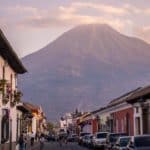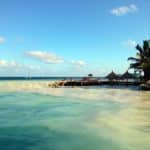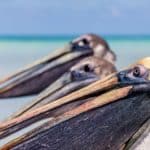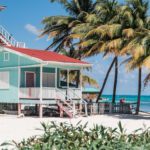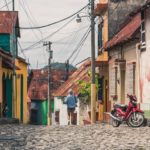Guatemala to Belize
Wander the cobblestone streets of Antigua, admire ancient Mayan ruins and unwind on the laidback island of Caye Caulker on this 10-day adventure from Guatemala to Belize. This trip spans two captivating countries, with different languages, distinct cultures and varied landscapes. From volcano-studded highlands to the chilled-out charm of the Caribbean coast, this trip delivers a hearty dose of history and culture, plenty of epic scenery and some well-deserved downtime.
10 days, from
$1,568
per person
GROUP SIZE
ACTIVITY LEVEL
Details
Countries Visited:
Belize
Guatemala
Accommodation: Hotel (7 nights), Lodge (2 nights)
Transportation: Private vehicle , Public bus , Local bus , Taxi , Ferry , Shared boat
Included Meals:
- 7 breakfasts
- 3 lunches
Group size: Minimum 1, Max 16
Minimum Age: 15
Gaze in wonder at the jungle-shrouded limestone temples of Tikal, one of the most impressive Mayan sites in the whole of Central America, as howler monkeys call from the canopy.
Relax and recharge on the white sands of Caye Caulker, a tiny Belizean island made for beach BBQs, snorkel trips and lazy afternoons spent swinging in a hammock.
Explore Livingston: a one-of-a-kind riverside town where the local culture is heavily influenced by the Afro-Caribbean Garifuna population.
Walk along cobblestone streets and shop for local handicrafts in the tiny inland island town of Flores.
Dig deeper into Mayan history – visiting lesser-known ruins and a mystical Mayan cave complex – around San Ignacio, a vibrant market town near the Belize-Guatemala border.
Itinerary
Hola! Welcome to Antigua. Surrounded by three volcanoes dominating the skyline, it wasn’t until the late 20th century that the city became the tourism hub of Guatemala. Today, the city is filled with coffee shops and international restaurants and is always buzzing with live music and salsa classes. Your adventure begins with a welcome meeting at 6 pm where you'll meet your tour leader and travel group. If you arrive with time to spare, why not get a taste of local tradition with a chocolate-making workshop in the ChocoMuseo.
As the seat of the Spanish colonial government, Antigua was once one of the most important cities in Central America. The city was destroyed by an earthquake in 1773, but many of the colonial-era buildings have been carefully restored. This morning, wander the quiet cobblestone streets with your leader, who will point out many fascinating markets and museums. Later you’ll learn how to make a tortilla using traditional techniques. The afternoon is yours to spend exploring the city and its surrounds. Prefer to take it easy? Grab a coffee on the main plaza and settle in for some people watching. Don't miss the chance to taste a tamale, a local dish served in a corn leaf. Or try pepian, a meaty dish of chicken, beef, pork, or all three at once, in a rich sauce. You’ll find the best value food next to the markets near the bus station.
It’s a long day of travel as you make your way to Rio Dulce by private vehicle. Depart early for the 8-hour journey, arriving mid-afternoon. Enjoy a wander around the city with your leader, learning some key Spanish phrases to make interacting with the locals a breeze. Rio Dulce, which means 'Sweet River' in Spanish, refers to both the Guatemalan river that flows from Lago de Izabal (Lake Izabal) to the Caribbean Sea and the town of Fronteras, which sits at the east end of the lake. Upon arrival, the rest of the day is free to enjoy at your leisure. Maybe stretch your legs on a jungle walk, rent a kayak for a bit of exploration or just laze in a hammock and enjoy the tropical surrounds.
Join your group on a boat ride down the river to Livingston, a laidback Afro-Caribbean town that offers a unique taste of Garifuna culture in a far-flung corner of Guatemala. It’s located 30 kilometres (18 miles) from Rio Dulce and the boat ride is spectacular, taking you through waters laden with water lilies, past tropical forests and through a deep canyon replete with river birds. The Garifuna population in Livingston are descendants of a community forcibly removed from the Caribbean by the British in the late 18th century. Livingston was one of the towns the displaced Garifuna settled in, and its relative isolation means the culture has remained undiluted by Guatemalan norms. Spend a little time here and perhaps grab a Garifuna meal like tapou, a creamy soup made with fish.
Travel to the township of Flores on Lago Peten Itza. On the way, pay a visit to Nuevo Horizonte, a ranch where 130 demobilised families settled after the signing of the Guatemalan Peace Accords in 1998. Beginning with no infrastructure and poor living conditions, the community cooperated to establish fish-farming, agriculture, reforestation and eco-tourism projects. Tour their nature reserve, have lunch on the ranch and speak to the locals about the origins of the community. Continue to Flores, where you’ll take an orientation walk with your group leader. Flores had a long history before it was colonised by the Spanish in 1697, most significantly as the capital of the Itza people after the fall of Chichen Itza. Spend your free afternoon wandering the island’s quaint streets or shopping for local handicrafts. Around 4 pm, the lakefront starts to hum with street food vendors, making it a good place to grab a bite.
Get up early for a guided exploration of Tikal National Park. Among the thick, evergreen jungle are some of the most significant remnants of the ancient Maya civilisation – plus an array of local wildlife, including coatis and howler monkeys. Wonder at the towering limestone temples and other monuments while pondering the mystery of the ancient city's demise. Spend a few hours playing archaeologist, and afterwards, say goodbye to Guatemala and head across the border to Belize. As the only English-speaking country in Central America, Belize is a great place to get chatting with locals.
This morning, you can choose whether you would like to relax in San Ignacio or take part in some of the other optional activities on offer, like a visit to the caves of Actun Tunichil Muknal (ATM caves). A living museum of Maya relics, the ATM cave system is home to ceramic pots and crystallised skeletons, preserved by the natural processes of the cave for over 1400 years. If you choose to explore the cave system (and it is highly recommended), you’ll spend most of the day there. If not, there are always more local ruins to explore above ground, including Cahal Pech, which was once the residence of a wealthy Maya family. Nature lovers may be interested in a trip to the Green Iguana Conservation Project, where a number of the scaly – and surprisingly large – beasts are protected.
If your idea of paradise is white sand, clear blue waters and palm trees, then you’re going to dig Caye Caulker. The island even has a motto: ‘go slow’. Arrive following a scenic boat ride and join your leader for an orientation walk, to help you get your bearings on the petite island. While the island is entirely walkable, you might like to hire a bike and cycle between beach bars and along quiet palm-lined streets. Can’t keep your eyes off those Caribbean waters? Get out there for a spot of standup paddleboarding, or if the mood strikes, join a sunset catamaran cruise for an unforgettable end to your first day.
Your time in Caye Caulker is all about taking it easy, so do as much (or as little) as you want with another day here. If you’re keen to find the best snorkelling spots, opt to take a full-day boat tour (just remember to slather on sunscreen). After a day of swimming and lounging in the sunshine, you’re sure to get hungry. Belize is famous for its barbequed food, with some of the best meals cooked on the roadside. Caye Caulker is famous for its lobster – not the cheapest meal you'll ever buy, but so (so) good. Always make sure that you respect the season: lobsters can only be caught here between June and February. If you’re out of season, how about some grilled shrimp and a lovely rum and coke made with the local firewater?
There are no activities planned for the final day and you are able to depart the accommodation at any time following check out. If you would like to spend more time in Caye Caulker, we’ll be happy to organise additional accommodation (subject to availability).
